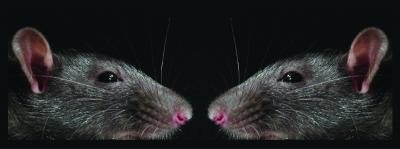Sniff, sniff. What did you say?
When animals like dogs or rats sniff one another, there might be more going on than you'd think. Research finds in rats that those sniffing behaviors communicate information about an individual's social status. In those encounters, more dominant rats act as primary sniffers, while subordinate sniffees actually slow their breath.

When animals like dogs or rats sniff one another, there might be more going on than you’d think. Research reported in Current Biology, a Cell Press publication, on March 7th finds in rats that those sniffing behaviors communicate information about an individual’s social status. In those encounters, more dominant rats act as primary sniffers, while subordinate sniffees actually slow their breath.
Wesson, Current Biology
"We know that rats and other animals can communicate through vocalizations, physical contact, odors, and also visual displays," says Daniel Wesson of Case Western Reserve University. "To find that there was an undiscovered form of communication these animals had been using right in front of us this whole time was truly a neat experience."
Of course, the animals do use sniffing to smell each other. But Wesson suspected that wasn't the whole story. After all, it takes very little sniffing for a dog to pick up the scent of another dog. Why, then, do they sometimes sniff one another so vigorously? And why might those sniffing exchanges lead to a fight in some cases but not others?
In the new study, Wesson used radio telemetry recordings of nasal respiration in rats to find that when one rat sniffs in the direction of another, the recipient of that attention will respond by slowing their own sniffing rate, as if to say "don't mind me." Further investigation showed that the direction of those interactions depended on the relative size and social status of each of the two animals. In the event that a smaller subordinate failed to lower their sniffing rate appropriately, the more dominant partner would often lash out aggressively.
Those sniffing exchanges continued even in animals unable to smell but could be eliminated by treating animals with oxytocin, a chemical sometimes referred to as the "love hormone."
Wesson says it is likely that the animals are communicating conflict avoidance and appeasement signals in their decisions to sniff or not to sniff. It's not unlike the way a male primate beats his chest to demonstrate superiority while juveniles in his presence bow down in submission.
That sniffing is used not only to collect but also to convey information highlights the complex social lives of animals. "It opens the door to a totally new line of understanding complex, microstructured social behaviors," Wesson says.
Original publication
Wesson: "Sniffing behavior communicates social hierarchy.", Current Biology, 2013
Original publication
Wesson: "Sniffing behavior communicates social hierarchy.", Current Biology, 2013
Organizations
Other news from the department science

Get the life science industry in your inbox
By submitting this form you agree that LUMITOS AG will send you the newsletter(s) selected above by email. Your data will not be passed on to third parties. Your data will be stored and processed in accordance with our data protection regulations. LUMITOS may contact you by email for the purpose of advertising or market and opinion surveys. You can revoke your consent at any time without giving reasons to LUMITOS AG, Ernst-Augustin-Str. 2, 12489 Berlin, Germany or by e-mail at revoke@lumitos.com with effect for the future. In addition, each email contains a link to unsubscribe from the corresponding newsletter.



















































